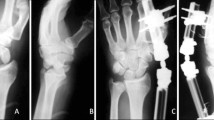Summary
Objectives
Anatomic reduction of the articular surfaces of the distal phalanx and restoration of extensor tendon function.
Indications
Avulsion fractures of the distal phalanx with a fragment exceeding 30% of the articular surface.
Contraindications
Inflammatory changes at the surgical site.
Surgical Technique
Open reduction through a dorsal approach and fixation with tension band wiring.
Results
From 1992 to 1997, this technique was employed in 40 patients. 38 could be followed up for an average of 25 months. Of these 38 patients, 6 could only be reached by telephone. Nineteen of the 32 patients had full extension, the remaining 13 had an extension lag of 10°. No limitation of flexion was seen 8 times, 18 patients had a lag of 10°, 5 of 20°, and 1 of 30°. Eighty-four percent of the 38 patients felt that the result was excellent or good. The following complications were noted: once an abnormal growth of the nail, and once an infection.
Similar content being viewed by others
References
Adler H. Die Zuggurtungsosteosynthese beim knöchernen Fingerstrecksehnenabriß (sog. Busch-Fraktur). Handchirurgie 1982;14:121–2.
Brüser P. Behandlung der Buschfraktur. Chir Prax 1977/78;23:319–21.
Busch W. Über den Abriss der Strecksehne von der Phalanx des Nagelgliedes. Zentralbl Chir 1881;1:1–5.
Ender HG, Hintringer W. Die percutane Versorgung von knöchernen Ausrissen der Strecksehnen und Seitenbänder an den Fingern mit dem „Hakendraht”. Unfallchirurgie 1986;12:143–7.
Hoch J, Fritsch H, Frenz C. „Busch-Fraktur”, „Knöcherner Strecksehnenausriß” oder „Fraktur der dorsalen Endphalanxbasis” — Synonyme? Handchir Mikrochir Plast Chir 1994;26:237–45.
Ishiguro T, Itoh Y, Yabe Y, Hashizume N. Extension block with Kirschner wire for fracture dislocation of the distal phalangeal joint. Orthop Traumatol 1999;7:105–11.
Jori R, Mettler M, Huber A. Der knöcherne Strecksehnenausriss am Fingerendglied: operative Technik und Ergebnisse. Helv Chir Acta 1994;60:867–70.
Lanz U. Physiologie der Sehnenheilung. In: Nigst H, Buck-Gramcko D, Millesi H, Hrsg. Handchirurgie, Band II. Stuttgart-New York: Thieme, 1983.
Narr H, Reill P. Die Behandlung des knöchernen Strecksehnenabrisses. Plast Chir 1980;4:102–7.
Ruland WO. New techniques: Bony avulsion of extensor tendons of the fingers. Orthop Traumatol 1998;6:300–7.
Sauerbier M, Krimmer H, Hahn P, Lanz U. Dorsale intraartikuläre Endphalanxfrakturen. Handchir Mikrochir Plast Chir 1999;31:82–7.
Author information
Authors and Affiliations
Corresponding author
Rights and permissions
About this article
Cite this article
Beyermann, K., Lanz, U. Tension band wiring for intraarticular fractures of the distal phalanx. Orthop Traumatol 8, 110–116 (2000). https://doi.org/10.1007/BF03181127
Issue Date:
DOI: https://doi.org/10.1007/BF03181127




